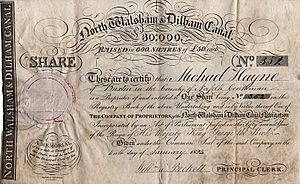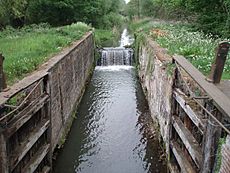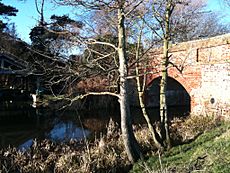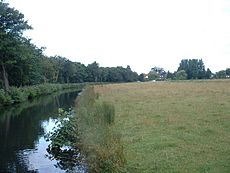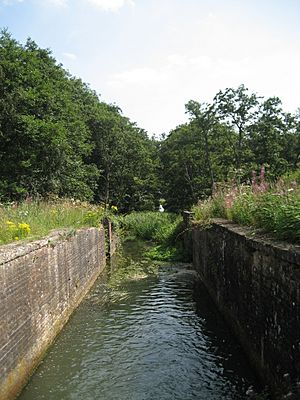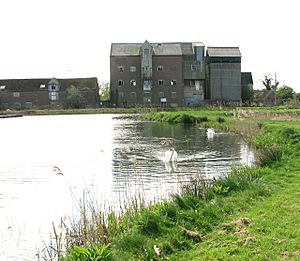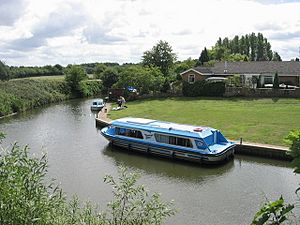- This page was last modified on 17 October 2025, at 10:18. Suggest an edit.
North Walsham & Dilham Canal facts for kids
| North Walsham and Dilham Canal | |
|---|---|
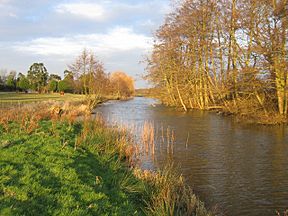
The canal looking northwards towards Tonnage Bridge
|
|
| Specifications | |
| Length | 8.7 km (5.4 miles) |
| Geography | |
| Start point | Swafield Bridge |
| End point | Merges with the River Ant |
The North Walsham and Dilham Canal is a special waterway in Norfolk, England. It was given permission by the government in 1812. However, building work did not start until 1825. This canal runs next to a part of the River Ant.
The canal has six locks. These are like water elevators for boats. They were built big enough for wherries. Wherries are traditional sailing boats. The canal officially opened in August 1826. It is about 8.7 kilometers (5.4 miles) long. It goes from two bone mills in Antingham to the River Ant at Smallburgh.
The canal was used to carry animal parts for the bone mills. It also moved farm products. But it was cheaper to bring coal by sea to Mundesley beach. Then it was moved by cart to North Walsham. So, the canal was not used much for coal.
The canal did not make a lot of money. It was sold to different mill owners. The part of the canal above Swafield locks was stopped being used in 1893. From 1922, the North Walsham Canal Company owned it. This company was started by Edward Cubitt and George Walker, who owned mills. The last time the canal was used for business was in 1934. It was not taken over by the government in 1948 like other canals.
Later, people started to enjoy canals for fun. The North Walsham and Dilham Canal was seen as easy to fix up. But restoration work did not begin until 2000. The East Anglian Waterways Association (EAWA) started volunteer work parties. In 2008, the North Walsham and Dilham Canal Trust was formed. They now work together with the EAWA.
In 2009, a part of the canal was sold to the Old Canal Company. They have been working to fix two locks and the water sections between them. Their goal is to run Bacton Wood Mill using water power again. In 2012, the Environment Agency stopped the rewatering for a while. But talks are still happening.
The canal served six mills along its path. This included the two bone mills at Antingham. Bacton Wood Mill has been there since 1086. Much of its current building is from 1747. Sir William Cubitt lived there. He invented the self-regulating windmill sail and the prison treadmill. When the millpond at Ebridge was cleaned and refilled, many new types of wildlife appeared. The area around the canal can flood. The Broads Internal Drainage Board helps by managing drains and pumping water.
Contents
Canal History: How it Was Built and Used
Before 1810, the River Ant could be used by boats up to Dilham. People then thought about making it possible for boats to go further north. William Youard and John Millington made plans in 1811. One of Millington's plans was used for a new law in 1812.
Some people in Worstead and Dilham were against it. They worried their businesses would fail if boats could reach North Walsham. But the new law was passed on May 5, 1812. It created the North Walsham and Dilham Canal Navigation company. This company could raise £30,000 by selling shares. They could get another £10,000 if needed.
Building the canal did not start until 1825. One reason for the delay was a claim for money by Issac Harris Lewis. He owned his own boat landing (staithe) at Dilham. He thought the new canal would hurt his business. In April 1825, he was given £1,500 as payment. Work started that same month. About 100 men from Bedfordshire were hired.
John Millington designed the canal. He was the engineer for the project. But Thomas Hughes actually built it. Hughes had worked on other canals in Scotland. Millington was from Hammersmith in London. This was his only canal-building project. Later, he went to the United States of America. He wrote a book called 'Elements of Civil Engineering'. This book has a lot of information about building canals.
The canal runs mostly next to a part of the River Ant. But it is not in the river itself. So, it is a true canal, not just a river that boats can use. The canal needed six locks. These locks raised the water level by about 17.7 meters (58 feet). The canal is about 13.2 kilometers (8.2 miles) long.
The locks were made for wherries. These boats were about 15.2 meters (50 feet) long and 3.7 meters (12.3 feet) wide. Boats could reach Cubitt's Mill by June 14, 1826. The canal officially opened on August 29, 1826. Water for the canal came from ponds at Antingham. But only small boats could use the link to the ponds. Wherries used a special basin next to Antingham Mills. Fees for using the canal were collected at Tonnage Bridge. There was a boat landing and a small house there.
How the Canal Was Used for Business
The canal was mainly used to carry animal parts (offal) to the two Antingham Bone Mills. Other things carried included manure, flour, grain, coal, and farm products. But carrying coal was not very profitable. The fees were too high. It was cheaper to bring coal by ship from the north. It would land on the beach near Bacton or Mundesley. Then it was taken to North Walsham by cart. Later, trains carried most of the coal.
Most boats on the canal were wherries. They needed about 0.9 meters (3 feet) of water. They could carry between 18 and 20 tons of goods. Some wherries had a special design called a slip-keel. The bottom part (keel) of a loaded boat could be unbolted. This helped them get through the shallow parts of the canal. Once unloaded, the keel was put back. This allowed the boats to use more sail. When the keels were off, they were towed behind the boat. This kept them wet so they would not warp. A smaller 12-ton wherry often carried vegetables. It went between Antingham and Great Yarmouth. It was known as the "cabbage wherry."
When the Canal Was Used Less
The canal did not make much money. In 1866, the company got permission to sell the canal. This could happen if three-quarters of the shareholders agreed. In 1885, they decided to sell it. Edward Press, who owned Bacton Wood mill and had many wherries, wanted to buy it. The sale finished on March 16, 1886. The price was £600. This money was supposed to be given to the shareholders.
Most shareholders (446 out of 586) were found. But after paying some, the lawyer handling the sale, James Turner, ran off with the rest of the money. The owners felt they should pay the money themselves. But they did not do it right away. No shareholders asked for their money. Finally, in 1896, five of them, including Edward Press, put in £110 17s 7d (£110.88). This money was given to those who had not been paid.
In 1887, Walter Rye became the clerk. He noticed some problems with how the company was run. Edward Press was the general manager. But he was not supposed to be, because he made money from the canal. Also, there was no treasurer, even though the law said there should be one. There was also no way to officially close the company. Rye's concerns were not listened to. Nothing changed, and Press kept running the canal.
In 1893, the upper 2.25 kilometers (1.4 miles) from Swafield lock to Antingham were no longer used. But in 1898, boats still brought 6,386 tons of goods to the canal. About 5,000 tons were loaded to be shipped out. And 400 tons were moved within the canal. Trade slowly went down.
Edward Press was one of the first people to support canal tourism. He put an advertisement in a book in 1888. It described wherries that could be rented. The boats came with two crew members. They had a ladies' cabin and a gentlemen's cabin. These could also be used as a day room. Press died on July 2, 1906. A director from another company bought the canal at an auction on September 11, 1907, for £2,550.
In August 1912, heavy flooding damaged several boat landings. It also caused a break in the canal bank above Bacton Wood Lock. The mill owners Edward Cubitt and George Walker bought the canal in 1921. They thought a new drainage board would take over the canal. But this did not happen. So, the two millers started the North Walsham Canal Co Ltd. They bought the canal in January 1922 for £1,500.
Cubitt and Walker cleaned out the canal from Wayford Bridge to Bacton Wood in 1927. But at the same time, they drained the upper part above Swafield Lock. The canal continued to be used less and less. The wherry "Ella" made the last business trip on the canal in 1934. It left from Bacton Staithe. Because the canal was not used much, it was not taken over by the government in 1948. Most other British canals were. It stayed owned by the North Walsham Canal Company.
In 1948, the company sold about 1,100 meters (1,200 yards) of the dry canal bed above Swafield Locks. It became farmland again. To make sure Ebridge mill still had water, the section from Ebridge to Bacton Wood was cleaned in 1957. Three years later, a pipe near Royston bridge got blocked. Instead of fixing it, the pipe was removed. The water from the canal was sent a different way. It rejoined the canal below Bacton Wood lock.
Restoring the Canal for Future Generations
In 1953, Robert Aickman and Teddy Edwards from the new Inland Waterways Association visited the canal. In 1972, David Hutchings said the North Walsham and Dilham Canal should be one of the easiest to restore. This was because none of its locks or bridges had been destroyed. But nothing happened right away. The canal slowly filled with mud and plants.
Tonnage Bridge fell down in 1980. A local landowner wanted to rebuild it. The new Broads Authority supported this. To help the work, the landowner bought 3.6 kilometers (2.25 miles) of canal below Honing Lock in October 1981. The price was £2,050. The bridge was rebuilt in the old style. The Broads Authority helped pay for it.
In 1993, the East Anglian Waterways Association (EAWA) decided to work harder to restore the canal. They did a study of the locks and channel. It showed that restoring the canal was possible. Then they paid for a full environmental study. North Norfolk District Council supported the idea in October 1999. But they did not think powered boats would use the canal.
The EAWA started volunteer work parties in December 2000. They cleared plants and made repairs at Briggate, Bacton Wood, and Honing. In 2008, the North Walsham and Dilham Canal Trust was formed. The Trust wants to "protect, save, and improve the canal for the community and the environment." They work with canal owners, landowners, the EAWA, and local groups. Since it started, the Trust and EAWA have done joint work parties.
About 3.6 kilometers (2.25 miles) of the canal were sold in 2009. This part included the section above Bacton Wood lock, the lock itself, the section below it, and Ebridge Lock. It took nine years of talks to complete the sale. The new owner, Laurence Ashton, wanted to refill this section with water. This would allow him to run Bacton Wood mill using water power again.
After fixing Ebridge Lock, the Environment Agency stopped the rewatering in April 2012. A public meeting in November agreed with the stop. But Ashton and his Old Canal Company have since fixed Bacton Wood lock. Volunteers helped them. The top gates are now in place. They used metal parts from the old gates and fixed the paddle gear. Bacton Mill quay (a loading area) has also been fixed.
At Royston Bridge, another quay has been restored. This is the only bridge that was made lower. The canal was put into a pipe here. This was done so heavy trucks could reach Bacton Gas Terminal. But now the gas is moved by pipes. So, there is less truck traffic. This means the bridge could be rebuilt to its original height. There is water in the canal up to the first Swafield locks. Michael Starling, who owns this part, is also working on restoration. He hopes boats will be able to reach Swafield.
Only the first 3.2 kilometers (2 miles) of the canal from the Smallburgh end can be used by powered boats. This goes up to Honing lock. However, a special boat called the Weasel was bought by the Old Canal Company in 2010. It used to be owned by British Waterways. This boat has cleaned out large parts of their section of the canal.
For the Millennium celebrations, the people of North Walsham made ten mosaics. One of them shows a Norfolk wherry.
Watermills Along the Canal
The canal served six watermills when it was working. At its northern end were two bone mills in Antingham. Antingham Upper Mill was a small mill attached to a cottage. It was at the southern end of Antingham Ponds. A small channel connected it to the Lower Mill. Several boats moved goods between these mills.
The Lower Mill was built in 1834 by Edward Harbord, 3rd Baron Suffield. His land was next to the new canal. He had built a boat landing on the canal in 1829. It is likely that Harbord owned shares in the canal project. He had said the canal must extend to Antingham to get his support. This was to help the area's economy.
Bones for making fertilizer were brought by wherry to a boat landing. This landing was 45.7 meters (150 feet) long and 24.4 meters (80 feet) wide. It was between the two mills. After trains arrived, bones were also brought to North Walsham railway station. The ground bone was sold to Fisons for fertilizers. Even though the canal was not used after 1893, the mill kept working until the 1920s. The buildings were taken down after the Second World War.
The Lower Mill was much bigger. It was built after the canal opened. It had two floors and was about 59.4 meters (65 yards) long. The channel between the two mills was filled in around 1905. The mill was not powered by water after that time. It then used a Crossley gas engine. This engine used anthracite and coke. Some of the coke was made from coal at the site. Milling stopped in 1935 or 1936. The mill was taken down in 1958.
Swafield Mill was a three-story building. It had a brick base. The middle floor had wooden boards. The top floor was built into the pantiled roof. Water from the River Ant powered it. In 1831, it ran two sets of grinding stones and two flour mills. By 1967, only the brick base was left. The mill pond had been filled in. However, the mill house, built in the mid-1700s, is still there. It is a Grade II listed building. It is made of brick with three stories and three sections. It has a roof of black glazed pantiles.
There has been a mill at Bacton Wood since the Domesday Book was made in 1086. The current building was rebuilt in 1747. It was changed a lot in 1825. This was because people expected more trade when the canal opened. It was made of white brick with a slate roof. The mill house next to it had a pantiled roof, but it was later changed to slate.
The cast iron waterwheel was 5.5 meters (18 feet) across and 2.4 meters (8 feet) wide. It was strong enough to turn three sets of grinding stones. The water supply was sometimes not enough in the summer. So, a steam engine was added in the late 1800s. Its boiler exploded around 1910. An 18 horsepower (13 kW) hot bulb engine replaced it. The mill was last used for business in 1944. By then, it was powered by a diesel engine. It was sold to be made into a house in 1967.
The Hornsby engine was sold to people who liked old machinery when the mill was restored in 1984. Laurence Ashton bought the mill in 1994. He hopes to run it using water power once his Old Canal Company refills the canal. There are four sets of grinding stones on the milling floor. Sir William Cubitt lived in the mill house when he was a child. He invented the self-regulating windmill sail in 1807. He also invented the prison treadmill in 1818.
The first records of a mill at Ebridge are from 1537. The Bishop of Norwich rented it to William Hogan. The current mill is made of red brick with a slate roof. It has five stories. Cubitt and Walker bought it in 1869. Cubitt and Walker Ltd ran it until 1998. In 1937, it was powered by an oil engine and by water. Most of the original machines were taken apart in 1966. A new mill for animal feed was built next to the brick building. It was powered by electricity in 1968. The waterwheel was removed in 1972.
W L Duffield and Son bought the mill in 1998. They moved the business to Saxlingham Thorpe and closed Ebridge Mill. After many years of talks, work began to turn the mill into homes in January 2015. The part of the mill building covered with asbestos sheets was taken down. The grain storage building, added in the 1950s, was also removed. The granary building is being made into three homes. The mill building is being made into three more homes. They will keep many of the original features. The restoration also includes fixing up the mill race (the channel that carries water to the mill).
Briggate Mill is sometimes called Worstead Mill. This is because it is in Worstead. It had a brick base. Above it were two wooden stories with weatherboards. But it was covered with corrugated iron when the weatherboards got old. The waterwheel was 4.3 meters (14 feet) across and 1.8 meters (6 feet) wide. It was a breastshot wheel. A steam roller mill was added in 1890. Later, the mill was changed to use electric power. The waterwheel was gone by 1955. The mill stopped being used for business in 1969. Cubitt and Walker moved their business to Ebridge Mill.
After being sold, the buildings were destroyed by fire on August 7, 1975. This was an attempt to get money from an insurance company. After a long trial, four men were sent to jail for the crime. The ownership of the mill pond is not clear. It is across the road from the mill site and dried up in the 1970s. People living in Briggate tried to make the land around the mill a village green. But a public inquiry in 2010 said no. Residents helped the EAWA and Trust work parties. They cleared part of the mill pond. It was refilled with water in 2011. It is expected to become a safe place for wildlife.
Managing Water and the Canal's Path
The canal is called a "main river." This means the Environment Agency can do work to prevent floods there. The area around the canal can flood easily. There are many drains to help with this. The Broads Internal Drainage Board (IDB) has managed these drains since 2006. Before that, the Smallburgh Internal Drainage Board managed them. Five IDBs, including Smallburgh IDB, joined to form the Broads IDB in 2005. The next year, they joined with two boards that managed the lower Yare.
At the upper end of the canal, flood risk is managed by drains. Water flows from these drains into the canal by gravity. In the lower parts, near Tonnage Bridge and Wayford Bridge, the land is flat. So, water cannot flow into the canal by itself. Pumping stations pump water from the drains into the canal. The Broads IDB keeps two pumping stations on the lower canal. Tonnage Bridge East Ruston Pump is on the east bank, just below Tonnage Bridge. Wayford Bridge Pump is on the south bank of Tylers Cut, west of where it meets the main canal.
The Canal's Route: Where it Goes
At its southern end, the canal begins at Wayford Bridge. This bridge carries the A149 road. The canal goes north-west. Soon, it reaches the junction with Dilham Dyke, which goes west. On the south bank, you can see the tower of Dilham Dyke drainage mill and a modern pumping station. Private ditches continue to the west. Tylers Cut turns north-west to reach boat moorings at Dilham Staithe and the Broadlands Arts Centre. Boats can only go as far as Brickworks Bridge. But there is a short private ditch beyond it.
Back at the junction, the canal goes north to Tonnage Bridge. There has been no path for walking (towpath) so far. But a public footpath follows the left bank. The canal curves to the west, passing the old branch to East Ruston. Then it turns north-west to reach the broken Honing Lock.
From the top of Honing Lock, a footpath leads to the Weavers Way. This is a long walking path. It follows the old railway line here. Near the Grade II listed railway bridge, built in 1881, a footpath has been made around Honing Staithe. This area has been cleared and refilled with water. The path was officially opened by Norman Lamb, the local MP, on September 28, 2008.
Continuing west and then north-west, the canal reaches Briggate Lock. You can see it from Briggate Bridge. The mill is south of the bridge. The mill pond and lock are north of it. A little further north, the railway used to cross the canal. The brick supports are still there. But the bridge has been replaced by a wooden footbridge. This bridge carries the Weavers Way.
The canal continues mostly north. It reaches Ebridge lock and mill. It passes the old ditch to the small village of Meeting House Hill on its western bank. In 2014, there was no public access to this part. But there are plans for a footpath between the two locks. Above Ebridge lock, the mill pond has been cleaned. The banks have been cleared. This has created a large area of open water. Wildlife has benefited. People have seen water voles, Eurasian otters, reed warblers, dragonflies, kingfishers, wood sandpipers, and a marsh harrier. A footpath along the canal gives access to the water.
Continuing north-west, the canal reaches Spa Common. This is east of North Walsham. A narrow, humpbacked, Grade II listed bridge carries Anchor Road over the canal. The mill is north of the bridge. It is waiting for a water supply. There is a footpath along the left bank of the canal. It goes most of the way to Royston Bridge. This is the only bridge where the canal was put into a pipe.
North of the bridge is the Mike Thurston Water Activities Centre. Young people camp and learn water skills there. There is a footpath along the canal's route from the pipe to Pigneys Wood. The canal was then crossed by the railway from North Walsham Town to Sheringham. The supports are still there. A bowstring bridge carries pipes across the gap. But the footpath that follows the old railway line goes down to the canal level. It crosses the canal on a wooden footbridge. The route continues west. It passes the two Swafield locks. The lower one still has water. Another Grade II listed bridge crosses the canal at Bradfield. The canal ends just below Antingham ponds.
Locks and Watermills Locations
| Point | Coordinates (Links to map resources) |
OS Grid Ref | Notes |
|---|---|---|---|
| Antingham Ponds | 52°50′33″N 1°21′38″E / 52.8424°N 1.3605°E | TG264325 | Original head of navigation. Antingham Bone Mills |
| Bradfield Bridge | 52°50′15″N 1°22′28″E / 52.8376°N 1.3745°E | TG273320 | |
| Swafield Bridge | 52°50′12″N 1°23′35″E / 52.8366°N 1.3930°E | TG286319 | 7.3 miles. Swafield Mill |
| Royston Bridge | 52°49′52″N 1°24′33″E / 52.8310°N 1.4092°E | TG297313 | 6.5 miles |
| Bacton Wood lock (No 4) | 52°49′28″N 1°24′39″E / 52.8245°N 1.4109°E | TG299306 | 6.0 miles. Bacton Wood Mill |
| Anchor Road bridge | 52°49′26″N 1°24′41″E / 52.8239°N 1.4115°E | TG299306 | 5.9 miles |
| Ebridge lock (No 3) | 52°48′57″N 1°25′42″E / 52.8159°N 1.4282°E | TG311297 | 5.0 miles. Ebridge Mill |
| Meeting Hill Branch junction | 52°48′17″N 1°25′24″E / 52.8047°N 1.4233°E | TG308285 | 4.1 miles |
| Briggate lock (No 2) | 52°47′42″N 1°26′00″E / 52.7949°N 1.4333°E | TG315274 | 3.3 miles. Brigate Mill |
| Honing Common bridge | 52°47′33″N 1°27′04″E / 52.7926°N 1.4511°E | TG327272 | 2.6 miles |
| Honing lock (no 1) | 52°47′26″N 1°27′22″E / 52.7906°N 1.4560°E | TG331270 | 2.1 miles |
| East Ruston Branch canal | 52°47′19″N 1°28′31″E / 52.7885°N 1.4753°E | TG344268 | 1.3 miles |
| Tonnage Bridge, Dilham | 52°46′52″N 1°28′46″E / 52.7811°N 1.4794°E | TG347260 | 0.9 miles |
| Dilham Dyke junction | 52°46′16″N 1°28′30″E / 52.7712°N 1.4751°E | TG345249 | 0.4 miles |
| Smallburgh junction with River Ant | 52°46′14″N 1°28′54″E / 52.7705°N 1.4817°E | TG349248 | 0.0 miles |

